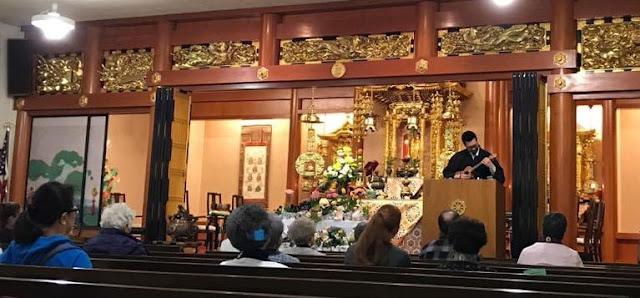"Do You Meditate?"
Buddhism is a 2,500 year old tradition and Buddhist teachings and practices take many forms. The way Buddhism is taught and practiced adapts to meet the needs of the people and cultures that follow it. One of the things that drew me to Buddhism was how diverse, vibrant, and adaptable it is.
At Idaho-Oregon Buddhist temple, we follow a tradition called "Jodo Shinshu Buddhism," a Japanese tradition geared toward busy people with jobs, families, and responsibilities, rather than toward monks/nuns. Meditation is not a major part of our Jodo Shinshu practice and not something that I, personally, have ever wanted to practice much. Our Jodo Shinshu tradition relies on Amida Buddha's compassion, not our own spiritual abilities. We listen to the Dharma; we say the Nembutsu (the name of Amida Buddha: "Namo Amida Butsu"); and we try to live a life of gratitude. We certainly can meditate, but we aren’t expected to. In fact, if you came by our temple on a typical day when we are open, you would be more likely to find us doing lots of other things like:
Chanting or sharing music:
Sangha Taiko group practicing in the temple basement
Nevertheless, many people assume that all Buddhists meditate. As a result, I often get asked for advice about meditation. In these cases, I share a meditation practice based on the teachings of the recently deceased Vietnamese teacher Thich Nhat Hanh that goes like this:
1) Find a
way to be comfortable. This can be sitting up straight in a chair. But it is
also OK to meditate lying down or even standing up (for example, in line at the
DMV). You just want to keep your body straight enough that you can take a slow
deep breath.
2) Before
you start, take a moment to create a connection with the chair or bed or floor you
are on. Notice your body touching the chair/bed/floor and notice that it is
strong enough to support you. Then mentally thank it for its support.
3) Breathe
in slowly (but comfortably) and as you are breathing in, think to yourself:
"Breathing in, I know that I am alive.”
4) Breathe
out slowly (but comfortably) and as you are breathing out think to yourself,
"Breathing out, I smile" and smile gently as you breathe out. Try
doing this breathing pattern for a set of at least 10 full breaths.
5) If you
get distracted just smile at yourself for being so distractible (but don't get
mad at yourself--that's a waste of energy!) and then start over again.
This is the
basic beginning point for all meditation--to be able to calm yourself down and
feel connected to the air your breathe and the materials that support and connect you with the larger world. Because
it can be done sitting, lying, or standing, with eyes open or closed, you can
do it almost anywhere! It is good to try when you are stressed, feeling worried
or anxious, when dealing with people who irritate you, or in loud environments. It
might help with insomnia.
But remember that Amida Buddha’s compassion supports us whether we meditate or not!
Namo Amida Butsu
Happy
Meditating (or not-meditating…)!
Rev. Anne








Comments
Post a Comment